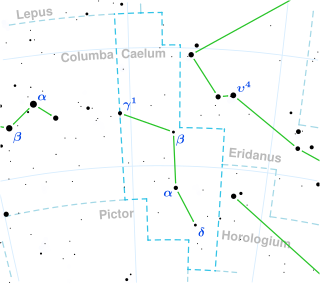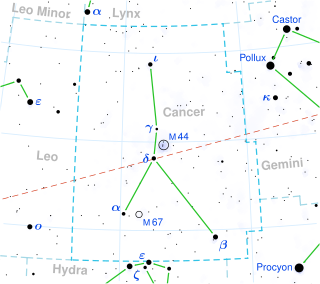
Omicron Velorum is a star in the constellation Vela. It is the brightest member of the loose naked eye open cluster IC 2391, also known as the ο Velorum Cluster.

Nu Caeli is a yellow-white hued star in the constellation Caelum. It has an apparent visual magnitude of 6.07, which indicates it is near the lower limit on brightness that is visible to the naked eye. According to the Bortle scale, the star can be viewed from dark suburban skies. Based upon an annual parallax shift of 20.3 mas as seen from Earth, this star is located 161 light years from the Sun.

15 Vulpeculae is a variable star in the northern constellation of Vulpecula, located approximately 243 light years away based on parallax. It has the variable star designation NT Vulpeculae; 15 Vulpeculae is the Flamsteed designation. It is visible to the naked eye as a faint, white-hued star with a typical apparent visual magnitude of 4.66. This object is moving closer to the Earth with a heliocentric radial velocity of −26 km/s.

Xi Leonis is a solitary star in the zodiac constellation of Leo. It has an apparent visual magnitude of 5.0 and is faintly visible to the naked eye. The distance to this star, as determined by parallax measurements, is roughly 229 light years.

V381 Cephei is a triple star system in the northern constellation of Cepheus. Its apparent magnitude is slightly variable between 5.5 and 5.7.

19 Monocerotis is a single, variable star in the equatorial constellation of Monoceros, located approximately 1,220 light years away from the Sun based on parallax. It has the variable star designation V637 Monocerotis, while 19 Monocerotis is the Flamsteed designation. This object is visible to the naked eye as a faint, blue-white hued star with a baseline apparent visual magnitude of 5.00. It is receding from the Earth with a heliocentric radial velocity of +25 km/s.

22 Orionis is a binary star in the equatorial constellation of Orion. It has the Bayer designation o Orionis, while 22 Orionis is the Flamsteed designation. This system is visible to the naked eye as a faint, blue-white hued star with an apparent visual magnitude of 4.74. It is located approximately 1,100 light years away from the Sun based on parallax. The system is moving further from the Earth with a heliocentric radial velocity of +28.80

λ Pavonis, Latinized as Lambda Pavonis, is a single, variable star in the southern constellation of Pavo. It is a blue-white hued star that is faintly visible to the naked eye with an apparent visual magnitude that fluctuates around 4.22. This object is located approximately 1,400 light years from the Sun, based upon parallax. It is a member of the Scorpius–Centaurus association.

Rho Pavonis, Latinized from ρ Pavonis, is a single, variable star in the southern constellation of Pavo. It is yellow-white in hue and faintly visible to the naked eye with an apparent visual magnitude that fluctuates around 4.86. The star is located at a distance of approximately 190 light years from the Sun based on parallax, and is drifting further away with a radial velocity of +8 km/s. It is a candidate outlying member of the Tucana Association of co-moving stars.

κ Phoenicis, Latinized as Kappa Phoenicis, is a single star in the southern constellation of Phoenix. It is visible to the naked eye as a white-hued point of light with an apparent visual magnitude of 3.94. The distance to this star is approximately 77.7 light years based on parallax, and it is drifting further away with a radial velocity of +11 km/s. It is a member of the Castor Moving Group of co-moving stars.

V Puppis is a star system in the constellation Puppis. Its apparent magnitude is 4.41. There is a binary star system at the center with a B1 dwarf orbiting a B3 subgiant star. They have an orbital period of 1.45 days and a distance of only 15 solar radii apart. However, the system moves back and forth, indicating that there is a massive object orbiting them with a period around 5.47 years. Based on the mass of the object, its lack of a visible spectrum, and circumstellar matter in the system with many heavy elements, it is probably a black hole. However, a follow-up study could not confirm this object, but found signs that there may be a third object which is fainter than the other components.

QZ Puppis is a class B2.5V star in the constellation Puppis. Its apparent magnitude is 4.5 and it is approximately 650 light years away based on parallax.

1 Puppis is a single star in the southern constellation of Puppis. It lies in the northern part of the constellation at a distance of about 790 ly, east of Aludra in Canis Major and just north of the white supergiant, 3 Puppis. This object is visible to the naked eye as a faint, red-hued star with an apparent visual magnitude of 4.59. It is moving further from the Earth with a heliocentric radial velocity of +32.4 km/s.

NV Puppis, also known as υ1 Puppis, is a class B2V star in the constellation Puppis. Its apparent magnitude is 4.67 and it is approximately 800 light years away based on parallax.

HD 59890 is a class G3Ib yellow supergiant star in the constellation Puppis. Its apparent magnitude is 4.65 and it is approximately 1,360 light years away based on parallax.

MX Puppis is a class B1.5IV star in the constellation Puppis. Its apparent magnitude varies irregularly between magnitude 4.6 and 4.9 and it is classified as a Gamma Cassiopeiae variable. It is approximately 930 light years away based on parallax.

KQ Puppis is a spectroscopic binary variable star in the constellation Puppis. A red supergiant star and a hot main sequence star orbit each other every 9,742 days. Its apparent magnitude varies between 4.82 and 5.17.
NW Puppis, also known as υ2 Puppis, is a star in the constellation Puppis. Located around 910 light-years distant, it shines with a luminosity approximately 1,108 times that of the Sun and has a surface temperature of 15,000 K. Anamarija Stankov ruled this star out as a Beta Cephei variable.

R Puppis is a variable star in the constellation Puppis. It is a rare yellow hypergiant and a candidate member of the open cluster NGC 2439. It is also an MK spectral standard for the class G2 0-Ia.

UX Orionis is a variable star in the constellation of Orion. It is a Herbig Ae star, located about 1000 light years from the Earth. At its brightest it is a magnitude 9.5 object, so it is too faint to be seen with the naked eye. UX Orionis is the prototype of the UX Orionis class of variable stars, which are young stellar objects that exhibit large, irregular changes in visual band brightness. UX Orionis was discovered by Henrietta Swan Leavitt.













